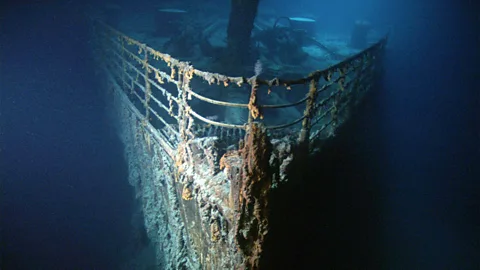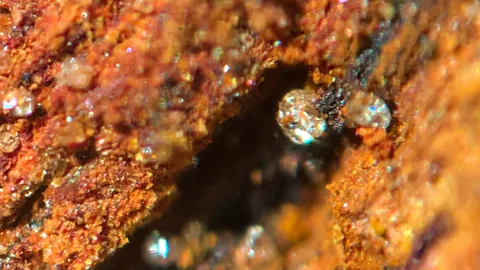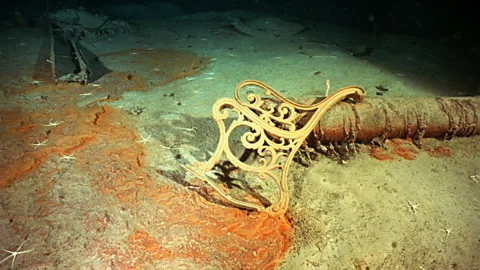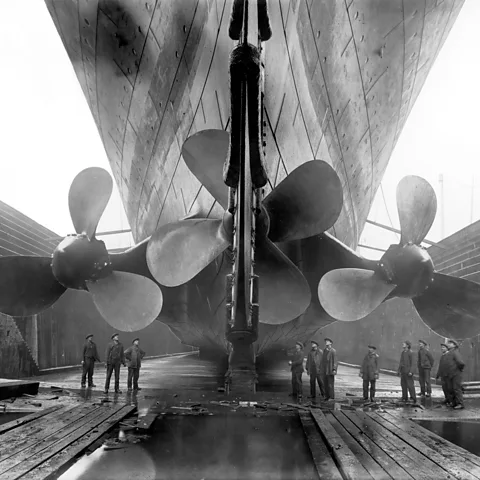A rusty smudge: What will happen as the Titanic wreck disintegrates

 Walt Disney Pictures
Walt Disney PicturesThe wreck of the Titanic is showing clear signs of decay on the sea floor at its resting place miles below the surface. What will its final fate be?
The RMS Titanic has spent more than 112 years in the crushing, total darkness of the deep ocean. When it sank on a cold, moonless night in April 1912, the 883ft (269m) long vessel broke apart, sending a rain of debris cascading down nearly 12,500ft (3.8km) to the silty ocean floor. The ship took more than 1,500 passengers and crew with it to their deaths.
Apart from the occasional visit from deep-sea submersibles and salvage missions bringing small artefacts to the surface, the wreckage has remained undisturbed as it has undergone the slow, steady process of decay.
Images from a recent expedition to the Titanic's wreck nearly 400 miles (640km) south-east of the Newfoundland coast have revealed the effects of this deterioration. Images of the Titanic's bow, with its distinctive railings, looming out of the darkness have become iconic since the discovery of the wreck in 1985. But in 2022, scans of the wreck showed the railing was starting to buckle and in the most recent visit to the wreck in 2024, a significant section has fallen now away. (Read more about the images captured during the latest expedition in this report by Rebecca Morelle and Alison Francis.)
It is a very visual indication of how the extreme environment in the ocean depths is breaking apart what remains of the world's most famous ship. The pressure of the ocean above it, water currents on the sea floor and iron-eating bacteria are causing the structure to collapse. And as it does so, the vessel is having a surprising impact on the ocean habitat around it.
Under pressure
As it sank, the Titanic split into two main sections – the bow and the stern, which came to rest nearly 2,000ft (600m) apart on the sea floor. The stern section sunk directly to the bottom, while the bow sank more gradually.
Stretching more than 1.3 miles (2km) from behind the stern to the beyond the bow is a scattering of belongings, fittings, fixtures, coal and ship parts that fell away as the Titanic sank. Most of the debris is found clustered around the stern section, which is a twisted tangle of steel, while the bow has remained largely intact. This is because when the vessel hit the iceberg, the impact tore apart a riveted section of the hull, allowing an estimated 43,000 tonnes of water to flood into the bow. When the stern section broke away, it still had compartments filled with air. As it spun towards the sea floor, the rapidly increasing water pressure caused the structure around these air pockets to implode, scattering metal, statues, champagne bottles and passengers' possessions as it did so.
On the sea bed, the Titanic endures water pressures of around 40MPa, which are 390 times greater than those on the surface. But as there are no air pockets left in the vessel, further catastrophic implosions are unlikely.
Instead, the weight of the vast ship itself is now playing a part in its demise. As the 52,000 tonnes of steel settle into the ocean floor, it is creating twisting force across the steel hull that is pulling the ship apart. Large cracks and fissures have been seen appearing in the steel plates of the hull by successive submersible missions, and the decking areas have been collapsing inwards.
 Charles Pellegrino
Charles Pellegrino"The iconic silhouette of the wreck will gradually change year by year – and not in its favour," says Gerhard Seiffert, a deep-water marine archaeologist who in 2022 led an expedition to capture high-resolution scans of Titanic wreckage with the deep sea mapping company Magellan. "The drop of the railing segment, which was still in place in 2022 when I was on the wreck with Magellan, or the collapse of the ceiling in the captain's bathroom years before may serve as examples," he says.
Corrosion, Seiffert says, is gradually weakening the structure of the ship as steel plates, beams and other load-bearing elements become thinner.
Devoured by bacteria
Like any iron or steel structure, the Titanic is rusting. But under 2.4 miles (3.8km) of seawater, the processes involved are different from those on land where oxygen and water trigger a chemical reaction to produce iron oxide. On the Titanic, much of the corrosion is being caused instead by bacteria.
The wreck is covered in a biofilm – a living blanket of bacteria, marine fungi and other microbes – which is feeding on the wreck itself. Initially the organic materials such as upholstery, pillows, towels and furniture provided a rich supply of nutrients for microbes drifting past in the ocean depths, causing them to settle.
Over time, other more extreme microbes have also taken hold, perhaps seeded from beneath the sea floor when the wreck ploughed into it, or drifting from distant hydrothermal vents on the mid-Atlantic ridge.
More like this:
• Rarely seen Titanic artefacts kept in secret warehouse
Assorted bacteria that oxidise the iron in the ship, along with others that produce acid, are eating into the metal surfaces. Other microbes that consume the rust these others produce have also been found flourishing on the wreck.
Visitors to the wreck have noticed it has become covered in "rusticles" – icicle-like formations hanging off the structure formed of oxidised metal. Living within these formations is a collection of collaborating and competing micro-organisms. When scientists broke off one of these rusticles in 1991 during the Akademic Mstislav Keldysh expedition to the wreckage, they were able to return it to the surface in a sealed container.
 Anthony El-Khouri
Anthony El-KhouriAmong the microbes the researchers discovered was a species of bacteria that was entirely new to science when it was discovered on the wreck. Halomonas titanicae, as the bacteria was later named, carries genes that allow it to break down iron.
Sulphur-reducing bacteria have also infiltrated areas that are devoid of oxygen, such as microscopic crevices created as the structure buckles. These produce sulphur, which is converted to sulfuric acid in seawater and then corrodes the metal of the ship, causing it to release its iron for other microbes to consume.
Scientists believe that that the stern of the ship accumulated a greater level of damage as the ship fell, causing it to deteriorate 40 years faster than the bow section.
"This is why the Titanic's bow is decaying from the aft end more, where the ship broke apart, and why the decay is progressing forward towards the prow or front region, which is relatively more intact," explains Anthony El-Khouri, a microbiologist at the Eastern Florida State College who has been working with the Canadian film director and deep-ocean explorer James Cameron to understand how microbes are contributing to the decay of the Titanic.
"The stern section appears to be melting into the seafloor since it is globally damaged, except the reciprocating engines, fantail, rudder, and propellors, which are more intact and resilient, therefore remaining somewhat recognisable," says El-Khouri.
One strange feature discovered inside the Titanic's Turkish Baths by Cameron during his 2005 expedition to the wreck are the formation of elaborate but delicate tendrils of rust that the director named "rustflowers". Using a remotely operated vehicle, he discovered the teak and mahogany woodwork in the spa had been unusually preserved because the baths were deep inside the ship and so were devoid of oxygen. This anoxic environment prevented bacteria and other microbes that might degrade the wood from living there.
But instead, the baths were covered in strange, branching growths of rust rising up to 1.5m (5ft) from the floor of the baths. Curiously, these "rustflowers" seemed to point in the same direction – following geomagnetic lines. El-Khouri, Cameron and their colleagues have found clues that suggest they are formed by colonies of rust-producing bacteria and "magnetotactic" bacteria living on the wreck. These unusual microbes contain nanocrystals of iron that allow them to align with magnetic fields. As these colonies of bacteria munch through the Titanic's steel, they leave behind trails of rust that "bloom" vertically along the Earth's magnetic field lines, says El-Khouri.
An enormous iron meal
The vast amount of iron-rich metal that the Titanic introduced to the sea floor has created an unusual ecosystem around it. As it corrodes, iron particles dissolve into the surrounding water, enriching it with a scarce, but vital nutrient in the deep ocean.
"Although iron is the most common element on Earth overall, solubilised iron is the scarcest nutrient in the ocean, which limits the success of any marine ecosystem," says El-Khouri. Volcanic hydrothermal vents are often a key source of iron in the deep ocean, and can help to support a wide variety of life, where bacteria play an important role in making the iron available to other creatures nearby.
"Titanic's wreck behaves essentially like a great iron oasis on the seafloor, a 46,000-tonne extrusion of iron in the shape of a former luxury liner," says El-Khouri. "This oasis provides a coveted nutrient, facilitating a vibrant deep ocean reef inhabited by starfish, anemones, glass sponges, benthic corals and sea cucumbers. And of course, iron bacterial colonies," he says.
El-Khouri and his colleagues found that these iron-related bacteria are not only eating the iron on the Titanic, but "are also capable of breathing it" instead of oxygen. "It's a remarkable ecosystem far removed from the Sun, with implications on the sort of extremophiles we might discover inside Europa and other cosmic oceans beyond Earth someday," he says. (Read more about why Nasa is exploring the deepest oceans on Earth.)
The Titanic's iron is also having an effect on the sea floor too. Rust flows are spreading out from the wreck at a rate of around 4in (10cm) per year and extend up to 6in (15cm) into the sediment. These flows of iron are particularly concentrated around the hull of the stern.
In total, scientists estimate that the Titanic is losing around 0.13 to 0.2 tonnes of iron from its rusticle formations every day. This has led some to estimate that the iron in the ships bow could totally dissolve in 280-420 years.
 Getty Images
Getty ImagesCurrents on the sea floor
But other factors could speed up the destruction of the wreck. Just as strong surface currents can carry boats and swimmers off course, the deep ocean is also scoured by underwater currents. Although not as powerful as those on the surface, deep ocean currents involve large amounts of water. They can be driven by winds at the surface affecting the water column below, deep water tides or differences in the water density caused by temperature and salinity, known as thermohaline currents. Rare events known as benthic storms – which are usually related to eddies on the surface – can also cause powerful, sporadic currents that can sweep away material on the seabed.
Research on the sediment patterns on the seabed around the Titanic, along with the movement of squid around the wreck, have provided insights into how the vessel is being buffeted by undersea currents.
Part of the Titanic wreck is known to lie close to a section of seabed affected by a stream of cold, southward-flowing water known as the Western Boundary Undercurrent. The flow of this "bottom current" creates migrating dunes, ripples and ribbon-shaped patterns in the sediment and mud. Most of the formations they have observed on the seabed are associated with relatively weak to moderate currents.
Sand ripples along the eastern edge of the Titanic debris field also indicate there is a westerly bottom-flowing current, while within the main wreckage site, scientists say the currents trend from north-west to south-west, perhaps due to the larger pieces of the wreck altering their direction.
Around to the south of the bow section, the currents seem particularly changeable, ranging from north-east to north-west to south-west.
 Alamy
AlamyAlthough none of these currents are considered to be particularly strong, they can still create disturbances that will cause the wreck to break apart as it weakens.
"Even currents generated by submersibles can cause weak structures to collapse," says Seiffert. "Although they may [also] remove some of the rusticles, which will delay corrosion at such areas," he says.
There is also a chance that the winnowing of these currents will eventually bury the Titanic wreckage in sediment before it has a chance to disintegrate completely.
But before then some of the more iconic sections of the wreck could disappear, much like the recent collapse of the instantly recognisable bow rail, which Cameron had his characters Jack and Rose stand behind in a famous scene in his 1997 film about the Titanic.
"I estimate that the more iconic regions of the wreck, such as its superstructure – Grand Staircase foyer, Marconi Room, Officer's Quarters – will disappear around the year 2100, making submersible landings aboard Titanic more challenging," says El-Khouri. "Thinner steel vanishes early, such as railings and deck houses on the boat deck. But even at this rate of decay, the wreck will require several centuries to fully disappear."
Large pieces of steel buried in the sediment, and so protected from the worst ravages of the metal-munching microbes could last longer – perhaps several hundred years, estimates El-Khouri.
But the ultimate fate awaiting the world's most famous shipwreck? An iron oxide smudge on the sea floor, studded with tiles, toilets and brass fittings.
"Porcelain objects, such as the vibrant tiles in the Turkish Baths, which are composed of fired silica, will endure almost forever," says El-Khouri.
It will be a rather humble monument to one of the most tragic examples of hubris and human fallibility. But then, perhaps, it's also a poignantly quiet end to a vessel that has been blighted with so much heartache.
--
If you liked this story, sign up for The Essential List newsletter – a handpicked selection of features, videos and can't-miss news, delivered to your inbox twice a week.
